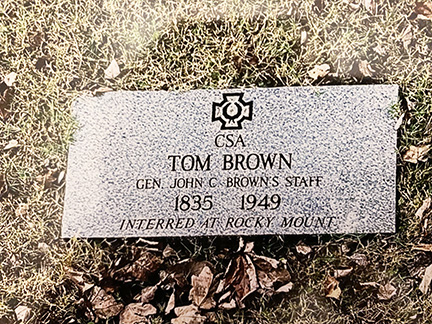By Logan Langlois
NASHVILLE, TN — One day, unaware of the history that was about to unfold in front of her, Black Nashvillian Lena Brown Prince received a call from the Daughters of the Confederate Army. They were contacting her as a part of their search for the families of 18 enslaved people who served in the Confederate Army and were asking her if she would like to come to a ceremony to honor the unveiling of a marker that would include her grandfather Tom Brown.
“My older brothers used to ask daddy if he was in the war,” Lena Brown Prince said. “And my daddy said, ‘No your grandpa wasn’t in any war, he just wore them suits, he loved them suits.’”
The Tom Brown she learned from her family was the only side of her grandfather she knew, though he lived until the old age of 114. She said the one memory she still has is of when he talked her parents out of making her get her tonsils removed on the same day she was supposed to go on a trip.
Prince said at the time of his enlistment into the Confederate Army, Tom Brown was enslaved. She continued that after the Civil War broke out, Brown’s slave master’s son was going off to join the rebellion, and Brown was told that he was going with him. Prince said she knew that Brown had been enslaved, but never knew the details, nor that he had even been involved in the Civil War.
“African Americans do not discuss things that are unpleasant,” Prince said. “They don’t talk about it, it’s unpleasant to even talk about it, so they don’t talk about it. That’s why my father didn’t even know. They just go on with life.”
Counter to the stories of some who wish to defend the Confederacy’s rebellion by spreading baseless information, the large amounts of enslaved people fighting for the Confederacy either in exchange for their freedom or to defend its cause is unproven. There is no evidence of a deployed Black populated military unit and only scarce singular accounts of individual Black soldiers whose freedom to willingly choose who to fight for could be hotly debated. Ironically, the biggest barrier preventing Black soldiers, willing or not, from serving on the front lines was the Confederacy itself, which made it illegal for enslaved people to serve, as Confederate legislatures didn’t trust Black people with guns, much less full Black military units.
Most Black people who served in the Confederate Army did it as enslaved peoples sent to serve by those who presided legal ownership over them. There, they would serve as noncombatants such as cooks, teamsters, and manual laborers, many cleaning up the dead after battle. It wouldn’t be until an amendment to the Confederate Constitution which allowed Black soldiers, not in exchange for their freedom; on March 13, 1865, that two Black companies of 50-100 men were authorized to be trained, only for the war to end less than three weeks later.
On the day of the marker’s unveiling in November of 2009, Prince would be joined by several extended family members. She said that they were glad that the marker commemorated Brown, though she thinks much more could be done for the descendants of enslaved people in the form of reparations.
“If other countries are paying it, then America certainly should pay it,” Price said. “They allowed it to go on, and on, and on.”
“No one wants to be owned by someone else,” Prince said. “And you don’t even have your name, you have their name, that’s cruel.”
Copyright 2023 TNTRIBUNE. All rights reserved.

